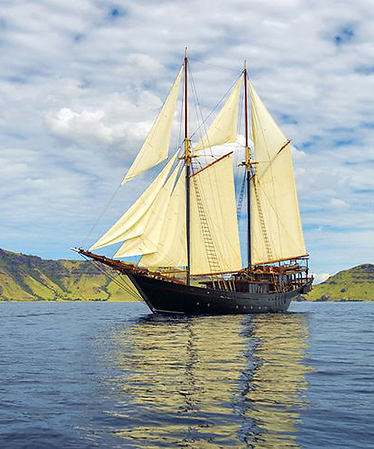


Exploring Indonesia’s islands on Aman’s new floating hotel
The latest offering from the Aman group isn’t a hotel but a sleek sailing boat
The sight of the Amandira bobbing away on turquoise waters is enough to make even the most committed landlubber want to slip aboard. The 52-metre yacht was launched earlier this year by Aman, the 30-strong hotel group known for immaculate design and formidable prices. It is inspired by the wooden phinisi that for centuries sailed through Indonesia’s tropical archipelagos carrying spices, fruits and other cargo.
The Amandira has been built from local hardwoods by craftsmen in Sulawesi and Surabaya, and tucked away in among the boat’s handcrafted timbers are three spacious double cabins and two smaller cabins with two bunk beds apiece. Up on the vast deck, there are cushions for lounging and a shaded area for when the sun is high. Indoors there is a dining table and a small library. There are 15 crew members — in attire more chic than any the passengers are likely to wear — who are there to prepare barbecues, picnics and freshly pressed juices, provide hot towels and diving or snorkelling gear, and, above all, to navigate the ship safely through the reefs and islands.
It’s not just that the boat itself is beautiful — it is where it sails and the adventures it offers that make it so beguiling. From April to September, when the seas and winds are at their calmest, the Amandira roams between the tiny island of Moyo and the Komodo National Park; from October to March, it explores the slightly wilder area to the north around the Raja Ampat archipelago. These seas are home to some of the richest and most diverse marine life in the world — about a third of the world’s aquatic species and more than 450 species of reef coral (compare that with the Caribbean, which boasts about 60).
These are the waters that drew the great 19th-century naturalist Alfred Russel Wallace, he of the Wallace Line, marking the point where Asian flora and fauna give way to Australasian species. The Amandira plies its way through a transitional zone known as Wallacea, where many of these species overlap. As far back as 1956, our more contemporary great naturalist David Attenborough also came here, to film his BBC documentary series Zoo Quest. Put simply, there are sights above and below the water that you won’t see anywhere else.
Earlier this month I spent five days aboard, sailing these magical seas and spotting wonderful creatures. Just lounging on the deck, we spent an hour marvelling at the antics of what seemed like a hundred dolphins following the boat. We had glimpses of the wobbegong shark and, up in the sky, we’d see sea eagles soaring, searching for prey.
On our first evening aboard we landed at the small island of Satonda and took the small path to see Lake Motitoi, a seawater crater lake lined with stromatolites (a rare form of algal reef). As we left, the darkening sky began to fill with flying foxes leaving the island to find fruit to eat further afield.
On the island of Rinca, we trekked to see the famous Komodo dragon. Grey and seemingly mostly half-asleep, they can grow up to three metres long — but it isn’t until they flick out their extraordinarily mobile tongues in search of the scent of blood that they begin to resemble the terrifying creatures of myth. They are easy to see, lounging around the kitchen huts at the base of the island, yet our guide, armed merely with a forked stick, was sufficiently nervous to make sure
that we kept well away. Why they can only be found on four islands — Komodo, Rinca, Gili Motang and Flores — nobody quite knows. it was under water that I found by far the more magical world. I don’t dive, and neither did anybody else in our party. We could have learnt onboard, under the instruction of Benoit Martin-Laval, the cruise manager, but we didn’t need to. Instead, we spent long and happy hours snorkelling, marvelling at the coral reefs, eyeballing fish of strange and myriad hues. One morning, Benoit found us a site where vast manta rays tend to gather and we snorkelled in and out among them as if we, too, had become creatures of the sea. We kayaked and paddle-boarded, had picnics on tiny islands fringed with pink-tinged sand and, on our last evening, we ate barbecued lobster on another deserted island surrounded by trees festooned with lanterns.
The joy of the Amandira is that you can go where you will, winds and seas permitting. It is designed to be taken over in its entirety so, unlike most of the other boats plying the same seas, you never share with strangers. And though that makes it expensive, if you can make up a group of 10 (the maximum the boat takes) and divide the cost, it doesn’t seem quite so bad. The package usually quoted is for five days but you can hire it for as long as you like.
What makes a perfect package is to do as I did: fly to Singapore, arriving early in the morning and connecting straight to Bali and thence to the Amanusa hotel, half an hour from the airport. I dined (deliciously) there and flew early the next morning to the island of Sumbawa.
From there, it is a short boat trip to the small island of Moyo and to Amanwana, the Aman group’s tented camp, where there are hills to hike up, golden orioles in the trees, cool, green pools by a waterfall to swim and dive in and, always, skies of a Tiepolo blue and seas that range from palest turquoise to deep dark indigo. The Amandira then picks you up from Moyo and off you sail for five days of bliss.
LUCIA VAN DER POST
